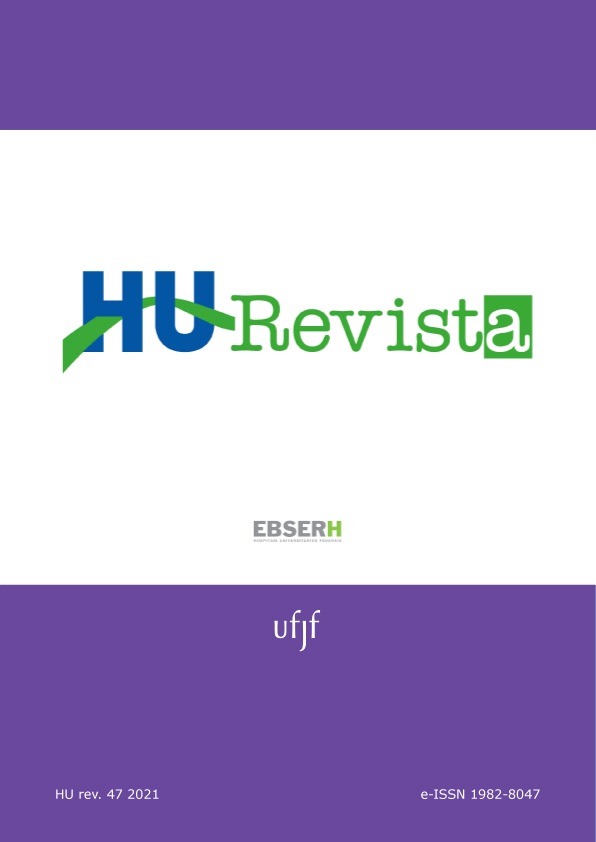Experience report: multidisciplinary approach in aplastic anemia – developing an outpatient model of care
DOI:
https://doi.org/10.34019/1982-8047.2021.v47.32984Keywords:
Anemia, Aplastic, Outpatient Clinics, Hospital, Comprehensive Health Care, Patient Care TeamAbstract
Introduction: Aplastic anemia is a rare hematological disease, which is associated with high morbidity and mortality. Treatment is defined by the patient's age, severity, comorbidities, and availability of a compatible donor for hematopoietic stem-cell transplantation. Care for patients with aplastic anemia is complex, due to the rarity of the condition and to the seriousness of the manifestations, and can be improved by the work of a multidisciplinary team, aiming at integrated health care. Objective: To describe the work of a multidisciplinary team in outpatient care for patients with aplastic anemia at a University Hospital. Experience Report: As of March 2016, the Hematology Service of a University Hospital reorganized the Aplasia Outpatient Clinic, proposing to carry out medical consultations, collection and assessment of laboratory tests, and transfusions, all on the institution's premises and on the same day of the week, decreasing the need for patient visits to multiple health services. Since then, 32 patients from the Zona da Mata Mineira and Campo das Vertentes mesoregions have been included in this clinical follow-up model, with a low rate of absenteeism in the scheduled consultations. According to the needs presented by patients or perceived by doctors, the Aplasias Outpatient Clinic offers, in addition to the routine care provided by the Nursing teams and the Transfusion Agency, assessment from the services for Psychology, Dentistry, Nutrition, Physiotherapy, Social Service, and referrals to other medical specialties. Conclusion: The multidisciplinary approach employed seeks to improve the quality of life of the patients, strengthening their relationship with professionals, adherence to treatment, and understanding of the disease not only as a medical-biological factor, but as a process linked to the patient's life history and social environment. We believe that this model can be reproduced in other services, aiming to increase the quality of care for people with aplastic anemia.
Downloads
References
Young NS. Aplastic anemia. N Engl J Med. 2018; 379(17):1643-56.
Schoettler ML, Nathan DG. The pathophysiology of acquired aplastic anemia: current concepts revisited. Hematol Oncol Clin North Am. 2018; 32(4):581-94.
Maluf E et al. Incidence and risk factors of aplastic anemia in Latin American countries: the LATIN case-control study. Haematologica. 2009; 94(9):1220-6.
Peslak SA, Olson T, Babushok, DV. Diagnosis and treatment of aplastic anemia. Curr Treat Options Oncol. 2017; 18(12):70.
Camitta BM, Rappeport JM, Parkman R, Nathan DG. Selection of patients for bone marrow transplantation in severe aplastic anemia. Blood. 1975; 45(3):355-63.
Killick SB, Bown N, Cavenagh J, Dokal I, Foukaneli T, Hill A et al. Guidelines for the diagnosis and management of adult aplastic anaemia. Br J Haematol. 2016; 172(2):187-207.
Scheinberg P. Activity of eltrombopag in severe aplastic anemia. Blood Adv. 2018; 2(21):3054-62.
Höchsmann B, Schrezenmeier H. Supportive care in aplastic anemia. In: Aljurf M, Gluckman E, Dufour C. Congenital and acquired bone marrow failure. London: Elsevier; 2017, p.52-71.
Ferreira AA, Vieira CMAS, Mota MA. Consumo de hemocomponentes por pacientes com anemia aplástica: estudo retrospectivo. Hematol Transf Cell Ther. 2019; 41(supl.2): S336.
Ministério da Saúde (BR). Portaria SAS/MS nº 1.300, de 21 de novembro de 2013. Aprova o Protocolo Clínico e Diretrizes Terapêuticas da Anemia Aplástica Adquirida. 21 de novembro de 2013 [acesso em 26 set 2020]. Disponível em: http://portalms.saude.gov.br/images/pdf/2014/abril/02/pcdt-anemia-apl-adq-livro-2013.pdf.
Ministério da Saúde (MS). Secretaria de Atenção à Saúde. Departamento de Atenção Especializada e Temática. Guia para o uso de hemocomponentes. 2. ed. Brasília: Editora do Ministério da Saúde; 2015.
Queiroz FR, França ALM, Pinheiro MGC, Silva SYB. Assistência de enfermagem ao paciente hematológico: um relato de experiência. 17° Seminário Nacional de Pesquisa em Enfermagem; 03 a 05 de junho de 2013; Natal. [Acesso em 27 ago 2020]. Disponível em: http://www.abeneventos.com.br/anais_senpe/17senpe/pdf/0650po.pdf.
Silveira RCCP, Galvão CM. O cuidado de enfermagem e o cateter de Hickman: a busca de evidências. Acta Paul Enferm. 2005; 18(3):276-84.
Ministério da Saúde (BR). Portaria de Consolidação nº 5, de 28 de setembro de 2017. Consolidação das normas sobre as ações e os serviços de saúde do Sistema Único de Saúde. [Acesso em 28 set 2020]. Disponível em: http://portalarquivos2.saude.gov.br/images/pdf/2018/marco/29/PRC-5-Portaria-de-Consolida----o-n---5--de-28-de-setembro-de-2017.pdf.
Vaisbich MH, Satiro CAF, Roz D, Nunes DAD, Messa ACHL, Lanetski C et al. Abordagem multidisciplinar para pacientes com cistinose nefropática: modelo para atendimento em uma doença renal rara e crônica. J Bras Nefrol. 2019; 41(1):131-41.
Franco CM; Franco TB. Linhas do cuidado integral: uma proposta de organização da rede de saúde. [Acesso em 10 jun 2020]. Disponível em:
Oliveira C, Cutolo LRA. Integralidade: algumas reflexões. Rev Bras Educ Méd. 2018; 42(3):146-52.
Costa AC. Integralidade na atenção e no cuidado a saúde. Saúde Soc. 2004; 13(3):5-15.
Cecílio LCO. Modelos tecno-assistenciais em saúde: da pirâmide ao círculo, uma possibilidade a ser explorada. Cad Saúde Públ. 1997; 13(3):469-78.
Downloads
Published
How to Cite
Issue
Section
License
Copyright (c) 2021 Adriana Aparecida Ferreira, Camila Mariana de Araújo Silva Vieira, Débora Wagner, Flávio Rodrigues Reis

This work is licensed under a Creative Commons Attribution 4.0 International License.
Cessão de Primeira Publicação à HU Revista
Os autores mantém todos os direitos autorais sobre a publicação, sem restrições, e concedem à HU Revista o direito de primeira publicação, com o trabalho licenciado sob a Licença Creative Commons Attribution que permite o compartilhamento irrestrito do trabalho, com reconhecimento da autoria e crédito pela citação de publicação inicial nesta revista, referenciando inclusive seu DOI.









